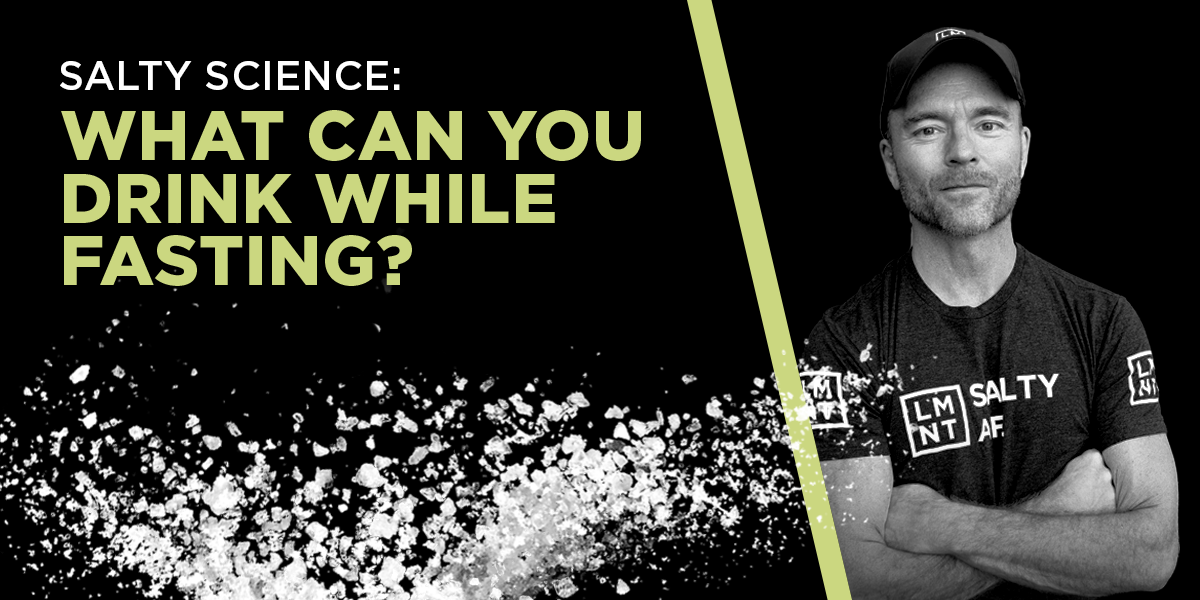When people ask me what to drink while fasting, I don’t typically give a long spiel. I could answer the question on an elevator ride.
Drink non-caloric beverages to thirst and make sure you’re getting enough electrolytes, especially sodium. I always emphasize the importance of salt because fasting makes you shed sodium like a young snake sheds skin. (Hint: It’s a lot.)
It’s that simple. You can run most fasting-related beverage questions through this framework and get your answer. But it seems that out of an abundance of caution, people often triple-check which drinks break a fast regardless.
Why? In my opinion, we’ve lost our sense of propriety and scale with regards to fasting. Folks’ heads spin with terms like autophagy and mTOR, but without much context. Whether coffee breaks a fast is actually a semi-interesting debate topic, but it’s not a mission-critical item. It doesn’t deserve hours of careful consideration. Too often we get tangled up in the minutia and focus on the wrong questions.
So let’s set the record straight: Fasting is NOT a binary proposition. It’s not “on” or “off.” It’s a spectrum with a lot of different positions. A drop of coconut oil or honey is not going to undo all the benefits of fasting. And instead of arguing about coffee, tea, or a drop of MCT oil, we should be talking about electrolytes while fasting. Why?
Perhaps the most compelling reason is that getting enough electrolytes while fasting can make the difference between feeling like a champ or a crusty, dried up sponge. Yes, fasting can be tough, mentally and physically, on the best of days. But fasting with inadequate electrolytes can be dangerous and downright miserable. And this misery will not enhance the benefits of fasting in any way, shape, or form.
Thankfully, it’s easy to get enough electrolytes without breaking your fast. I’ll cover that later, but—spoiler alert—the salt shaker and LMNT are both useful here. But first, we need to sync up on fasting. What does fasting mean? What can you drink while fasting? And how does fasting influence hydration needs? Keep reading.
Fasting Basics
To fast is to deny your body calories temporarily. That’s the basic definition. If this temporary break from food lasts under 36 hours, it’s considered an intermittent fast. If it lasts longer, it’s considered an extended fast.
Must fasting be a zero-calorie affair? Not necessarily. In fact, many fasting protocols allow for limited calories.
5:2, or 5 days of regular eating then 2 non-consecutive fasting days per week, for instance, is a popular intermittent fasting regimen that generally permits about 500 calories on fasting days. And Valter Longo’s Fasting Mimicking Diet (FMD)—shown to have clinical benefits—entails one 5-day stretch of similar calorie restriction per month.
Those are the logistics of fasting, but why would people voluntarily sign up for such deprivation? To answer, let’s take a little trip back to 20,000 BC. Back then, humans didn’t fast because they heard about it on a podcast. They fasted because the food kept running out.
Yet their bodies didn’t immediately shut down without food. When berries and rabbits weren’t available, they would turn to another source of energy: body fat. Even in a lean human, this energy source could last for days—and sometimes weeks.
What was a survival need then is a health intervention today. For obese and diabetic folks especially, fasting triggers a metabolic reset, leading to weight loss, better insulin function, lower heart disease risk, and more.
Keep in mind, though, that more fasting isn’t always better. It’s a stressful endeavor, and it pains me to see otherwise healthy folks suffering—bags under their eyes, sunken cheeks, and ashy skin—through extended fasts on a weekly basis. Specifically for lean, metabolically healthy people, I’m not sure how much upside there is to fasting vs., say, an additional strength training session each week. I’m currently in the minority on this, but I lay out this case in-depth in my talk, Longevity: Are we trying too hard?
In my experience, the sweet spot for most people is 13 to 18 hours of daily fasting. If you go beyond that, you should have a good reason for doing so. Again, there are tradeoffs between choosing more fasting or, for example, some Zone 2 cardio and/or strength training.
Breaking vs. Maintaining a Fast
What does it mean to break a fast? It’s a simple question that requires a nuanced answer. You could say that consuming calories breaks a fast, but many fasting protocols show benefits from merely limiting calories. And besides, not all calories are created equal.
The extent to which a food or drink “breaks a fast” hinges on two main factors:
- The number of calories consumed
- The type of calories consumed
The first factor is fairly straightforward. The more calories you consume, the more likely you will disrupt the fast. The second factor is the type of calorie. The greater the body’s insulin response is to a macronutrient, the more disruptive that nutrient will be. Here’s how macronutrients rank, from most to least disruptive to a fast.
- Carbohydrate
- Protein
- Fat
Why are carbs (especially those from refined sugar) the most disruptive macronutrient? Carbs cause the greatest release of insulin, a hormone that tells your cells to store fat. Insulin then suppresses the fat-burning state called ketosis and therefore disrupts the central driver of fasting benefits; most notably, the suppression of mTOR.
Still, I must remind you that the dose makes the poison. A teaspoon of honey in your tea or electrolyte drink won’t ruin your fast. Of course you could just as easily use stevia, but my point is that IF you want to use a splash of honey here and there, I do not see a problem. We’d do well to dispense with the nearly religious fervor that emerges around the nuance of fasting.
By contrast, fat has the smallest impact on the release of insulin and suppression of mTOR. That’s why adding MCT oil to your morning coffee won’t meaningfully interfere with your fast. However, I must remind folks that there are more calories in a gram of fat than a gram of carbs.
I have worked with folks who drink a ton of butter in their coffee, yet struggle to figure out why they are gaining weight and feel awful. Don’t get me wrong, butter is great. But we needn’t drink appreciable amounts of butter any more than we need to consume 1000 calories of sugar sweetened sodas each day.
Now that we’ve laid down some much needed nuance around fasting and calorie intake, let’s shift gears and focus on electrolyte needs while fasting. Don’t worry, this is much more straightforward and has a good bit less controversy surrounding it.
Staying Hydrated While Fasting
Most people are confused about how to stay hydrated while fasting. In general, they believe that drinking more water is better. Period.
It’s not. Yes, fasting has a diuretic effect and increases urinary fluid loss. But drinking plain water to replace those fluids is a poor strategy. It’s a poor strategy because in addition to losing water, you’re also losing electrolytes at a higher rate while fasting. And if you only replace the fluids, it can exacerbate the electrolyte imbalance. Specifically, drinking plaing water beyond thirst has the potential to dilute blood sodium levels. Add this to amplified urinary sodium losses and you have a formula for hyponatremia.
Hyponatremia is the medical term for low blood sodium. The symptoms include headaches, fatigue, weakness, muscle cramps, confusion, and—in severe instances—seizures, brain damage, and death. You often see hyponatremia in elite endurance athletes, who sweat out tons of sodium and drink plain water on a set schedule despite a lack of thirst. I think there’s a lesson to be learned here that folks can apply to their fasting regimen.
Now that you understand the basics of fasting hydration, let’s cover some specific fasting-friendly beverages.
What Can You Drink While Fasting?
Don’t agonize over this question. If you’re drinking a non-caloric beverage to thirst, it’s generally fine. And if the beverage contains a little bit of fat, that’s not a huge deal either.
While fasting, you’ll want to avoid high-sugar, high-calorie drinks like:
- Soda
- Fruit juice (even if there’s “no sugar added”)
- Sugary sports drinks
- Milk, chocolate milk, and hot chocolate
- Smoothies
- Protein drinks
- Alcoholic beverages
- Most latte, cappuccino, mochaccino, and frappuccino drinks
That’s the basic gist, but let me expand on these common questions:
Can I drink water while fasting? Yes, just drink to thirst and make sure you’re getting enough sodium. “Dry fasting” will cause dehydration. I don’t recommend it unless you really know your stuff.
Can I drink coffee while fasting? I say, go for it. Coffee contains loads of antioxidants and may enhance a fasting-induced cellular recycling program called autophagy. The funny thing about coffee is that it enhances autophagy whether or not you are fasting.
Can I drink tea while fasting? Yes. No calories, lots of antioxidants.
Can I drink diet soda while fasting? I recommend finding a zero-calorie soda sweetened with stevia or monk fruit. Artificial sweeteners like aspartame and sucralose aren’t very insulinogenic, but they may have funky effects on gut bacteria.
Can I drink bone broth while fasting? A mug or two of bone broth shouldn’t meaningfully disrupt your fast. It does contain a bit of collagen protein, but the amino acid profile (glycine, proline, etc.) is fasting-friendly.
Can I drink electrolyte water while fasting? Please do, provided the electrolyte drink doesn’t contain sugar.
The Importance of Drinking Electrolyte Water
I can explain most of what you need to know about hydration in one sentence. This sentence covers fasting hydration, keto hydration, endurance hydration, strength hydration, and—most importantly—everyday hydration.
If you follow this rule, you’re good in 95% of hydration situations. (And it’s not hard to follow).
The rule is: Drink electrolyte water to thirst.
Drinking electrolyte water to thirst ensures you replace lost electrolytes AND lost fluids. It not only prevents dehydration but also the dangerous consequences of overhydration.
LMNT is my science-backed answer to this need. This tasty electrolyte drink mix is zero sugar, zero junk, and totally fasting-friendly.
Just 1-2 sticks during your fast (1-2 grams of sodium) can make a massive difference. Thousands of people have felt this difference—including professional athletes—which is partially why LMNT has caught on in such a big way.
Of course, LMNT isn’t the only way to get electrolyte water. It’s just convenient and tasty. You can check out this article for more ideas. But compared to other products, it’s the only mix with enough sodium to move the needle.
To wrap up, when it comes to fasting hydration, electrolyte water is the answer. I like when the best solution turns out to be a simple solution, don’t you?

